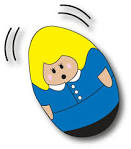As mysterious as the workings of the human body is, we massage therapists have learned a few tricks to bring errant, dysfunctional muscles back to working order.
I continue to be impressed by the methods of active release, also known as myofascial release, in reviving elements of structure and function to certain muscles.
I recently had the fun of trying to extricate a “burning” sensation in the left lumbar area over the area we associate with discs L-5 and S-1. This is a frequent complaint of people coming in for massage, and sometimes restoring circulation and tone don’t quite fix this problem.
Active release involves allowing the therapist to palpate the errant muscle and drawing it  through a complete range of motion. What people sometimes forget in this venue is that complete range of motion must be done by the client, not the therapist, to truly meet the definition of active release.
through a complete range of motion. What people sometimes forget in this venue is that complete range of motion must be done by the client, not the therapist, to truly meet the definition of active release.
This took a good trusting relationship between me, the therapist, and my client. It helped that it was not the first time I have seen this client. It also helped that the client was suffering enough to be gung-ho about trying the step.
First, I demonstrated the full motion range to the client, then I asked the client to go through the motion with my verbal prompts. The actions of the suspected muscle, the multifidus, are varied between spinal stabilization in standing and bending, especially while holding a weight in front of the spine. I usually re-discover the aaaargh-factor of the multifidus muscle when I am trying to lift boxes onto a shelf in the garage. Or take them out.
Clients will come in and report such activity as garage-cleaning, house-cleaning, tub-cleaning, etc., followed by pain in the area later in the evening. If it has been a bad lift, the pain is immediate.
Once in a while a client will report trauma, such as falling off a ladder, or a fall during gymnastics, that will make me believe the mutlifidus is now stabilizing a spinous process or transverse process fracture. Off to the doctor they go. I can do active release for the multifidus after the fracture has healed.
This client was sitting on the massage table, back to me, while I palpated the area of the multifidus, just lateral to the spine and about a half-inch into the myofascial bundle. I kept constant pressure on the multifidus as the client bent forward, bent back and then rotated to the opposite side and bent forward. When the multifidus is particularly out of sync, I may do this with the client on their side and asking them to arch the back in this wobble-toy motion.
Give this technique a try with your massage-trading partner to see how it works for you. It’s another trick to hang onto when the clients present with a big pain in a very small area. Do you have your own version of this technique? I would love to hear some more….
